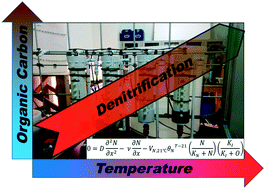Quantifying the temperature dependence of nitrate reduction in woodchip bioreactors: experimental and modeled results with applied case-study†
Abstract
Temperature significantly influences nitrate removal rates in woodchip bioreactors (WBRs), which are increasingly being adopted as engineered natural treatment systems for urban stormwater, agricultural drainage, and wastewater. In this study, three replicate columns with 15 month aged woodchips were operated under steady-state conditions with a synthetic stormwater matrix at three measured flow rates and in four temperature-controlled settings (4–30 °C). Dissolved oxygen (DO), nitrate, and dissolved organic carbon (DOC) concentrations were measured along the depth profiles of the columns. Temperature explained 45% of the variance in the measured nitrate removal rates and 40% of the variance in the measured DOC production rates. We used these data to adapt our previously-developed and validated WBR mechanistic model for different temperatures, flow rates, and influent nitrate concentrations. DO inhibition influenced nitrate removal rates at influent nitrate concentrations <2 mg-N L−1; above that, nitrate removal could be effectively modeled as a zero-order reaction with temperature dependence using a simplified Arrhenius equation with a temperature coefficient (θ) of 1.16. The high temperature dependence suggests WBRs may be most cost/space efficient in applications with elevated water temperatures, such as wastewater effluent. We applied WBRs to a case study scenario site in Sonoma County, California. Temperature and variable flow led to a 3–6X higher annual nitrate removal rate in wastewater effluent than stormwater. Comparing nitrogen removal technologies, WBRs were the lowest cost per kg N removed using existing infrastructure to comply with future wastewater N restrictions to San Francisco Bay in a cost-efficient, environmentally-friendly manner.



 Please wait while we load your content...
Please wait while we load your content...